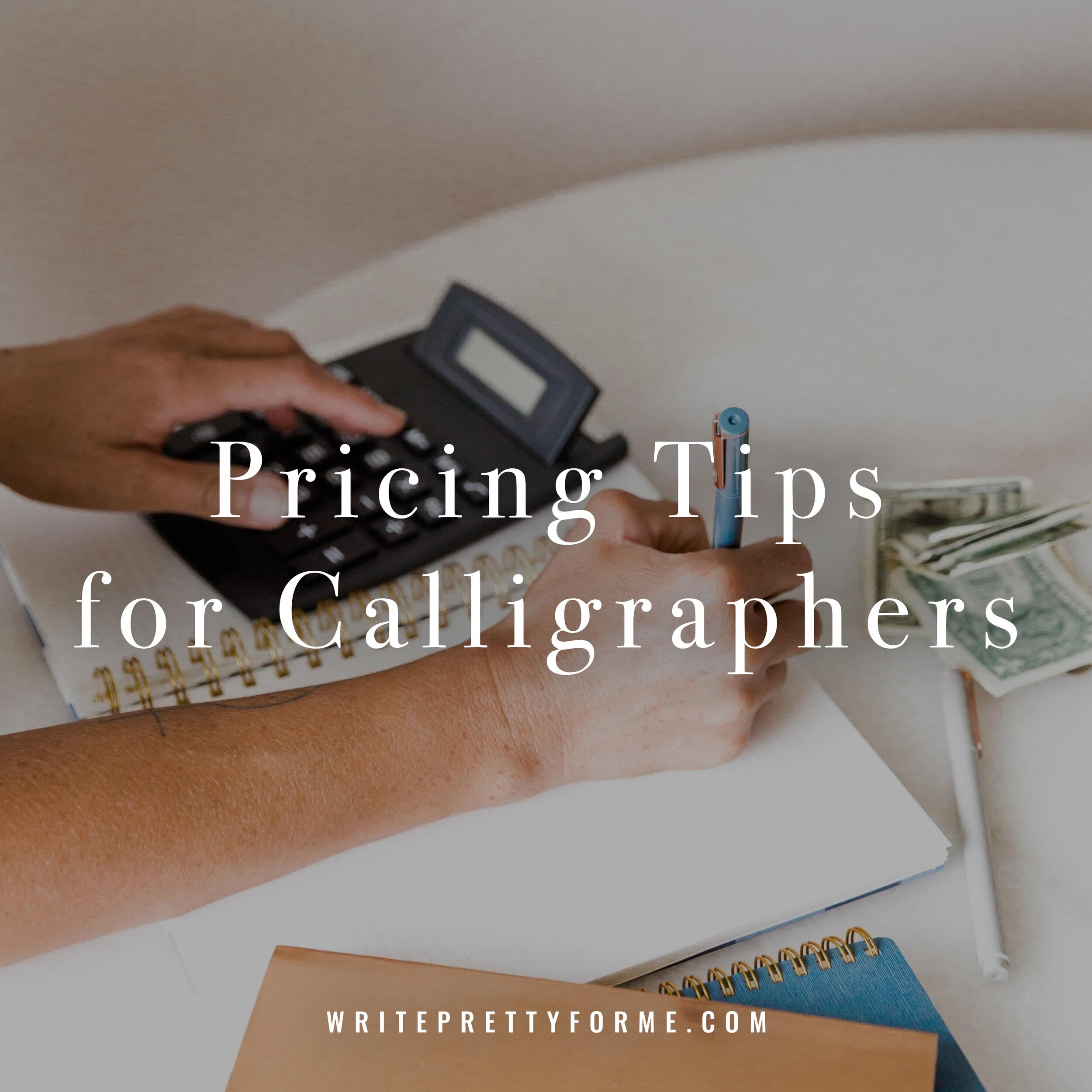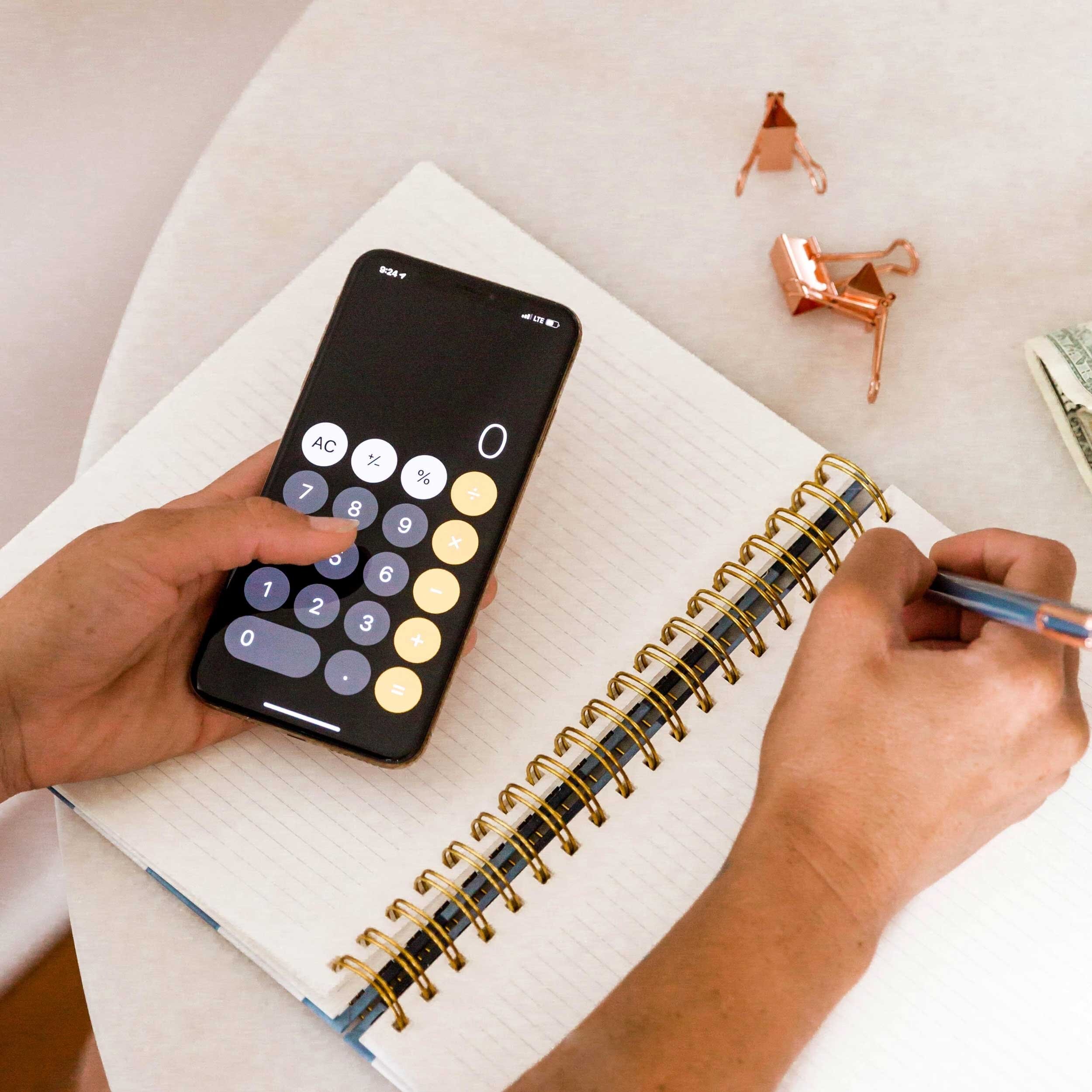Pricing Tips for Calligraphers
October 20, 2020

I know I talk a lot about pricing around here, but that’s because I know that it’s one of the most anxiety-inducing topics for us creatives. When talking with fellow calligraphers, they always express how overwhelmed they are with pricing, how they have no idea where to start, they don’t know how to charge what they’re worth, and usually what happens is they just throw their hands in the air and walk away from pricing all together.
And I get it ! because I’ve been there. I struggled with pricing my calligraphy services for years. I’d pull random numbers out of my head based on what sounded like a reasonable price, what I would pay for a certain project, and what I saw on Etsy instead of basing my pricing on hard numbers, like what my material costs were, how much time it would take to complete each project, and what I wanted and needed to be making in my business. I floated along like this for awhile and put a bit of money in my pocket here and there, but eventually, I realized that if I wanted to achieve my business and life goals (like quitting my corporate job, pursuing Write Pretty for Me full time, moving into a studio space and still having extra money to live my life), I was going to have to get serious about my pricing.
Once I started looking at my pricing objectively instead of emotionally, I watched my income grow! Eventually, I was able to replace my corporate salary with the money I was making from my business and in 2019 I was able to move into a studio space. All of my business goals have come to fruition because I’m no longer overwhelmed with pricing and no longer pricing based on my emotions. I have a solid pricing structure in place and a few “rules of thumb” that I follow to help make sure that I’m putting money in my pocket with each and every job.
This past month, Amanda Reid (Amanda Reid Designs and founder of Calligraphers of Color) asked Shaochen Wu (Monstera Gold, Calligraphy Ceo and co-creator of The Creative’s Pricing Toolkit) and I to share our pricing tips with the Calligraphers of Color community as part of their October Business Basics series. For today’s #tuesdaytips, I’m sharing and expanding upon them here in the hopes of helping you flourish in your creative biz!
Pricing Tips for Calligraphers
Value your time
As calligraphers, our most important and valuable asset is our time. It takes time to create each project, email with the client, package everything up, order supplies, etc.. So before you do anything else, decide how you’re going to value your time by setting your hourly rate.
Not sure how to come up with your hourly rate? Start by thinking about the financial goals for your business and work backwards, or think about trade-offs…in other words, “how much would someone need to pay me to create this calligraphy piece rather than spend the time with my family?”
If you’re looking for a formula to help you calculate your hourly rate and what factors to consider, there’s a worksheet included in The Creative’s Guide to Pricing that breaks everything down and helps you come up with an hourly rate that works best for you and your business!
It’s important for me to point out that although I’m advising you to come up with your hourly rate first before doing anything else, this isn’t a number that you’re necessarily going to share with your client. There are only a handful of scenarios in which I suggest pricing by the hour, but for the most part, I’d advise you to give a flat, project fee. (I break down when to charge by the hour or by the project in The Creative’s Guide to Pricing!)
Don’t fall into the comparison trap
I know, it can be so tempting to scroll through Etsy and use the pricing you see there as a starting point for setting your own pricing. But please don’t do it!
There’s nothing wrong with doing a little market research, but don’t fall into the trap of basing your pricing solely off of what you see on Etsy! When you look at other people’s pricing, you don’t have the context behind their skill level, financial goals, local market, and so many other factors. You’re using an unfair comparison to assess your price! Instead, use your hourly rate and your “hard” business numbers (like material costs, overhead expenses, etc.) to set your pricing.
You are not your ideal client
Remember when I said earlier that I used to price my services based off of what I would pay? Yeah, that wasn’t a smart move because I’m not my own ideal client!
Just because I might not pay x-amount for a calligraphy piece doesn’t mean that others won’t. First of all, I am a calligrapher, so I don’t need the service of calligraphy. However, those who can’t do calligraphy and do need our services see value in what we’re offering and are willing to pay a premium.
Rather than pricing based on emotion and what you would pay for something, set your pricing using…ding ding ding!: your hourly rate.
Don’t take the “No’s” to heart
Let’s be honest: rejection sucks, and you’ll probably hear “no” a number of times, or be straight up ghosted But guess what? That actually means you’re pricing correctly!
Pricing too low may get you more clients, but it also means that you’re undervaluing your time as well as the talents of other calligraphers.
Think about it this way: would you rather make $1,000 from 10 jobs or $1,000 from 5 jobs? And then you have that extra time to take on more clients and increase your income!
It’s important to remember that even though you may want to, you can’t please everyone. There are plenty of people who will see the value in what you offer and be willing to pay for your service, so stay focused on the people who are saying, “yes!”
Put a pricing structure in place
One of the hardest parts about pricing calligraphy work is that so much of it is custom. I used to have to calculate a new quote for every inquiry that came in …until I finally wrote down a pricing structure in google sheets that listed my base price for a variety of items along with the material costs. This gave me a starting point for almost every inquiry that came in and then I could increase my pricing from there depending on what the project entailed.
The Price Book Template in The Creative’s Pricing Toolkit is this exact structure in an editable excel worksheet and it comes with pre-calculated cells so all you have to do is plug n’ price! I use this exact worksheet now in my biz.
Bonus Tip!
Keep track of your inquiries and bookings! This is a great way to determine if your pricing is too low, too high or just right. It’s also a useful way to help you determine if and when you should raise your prices!
And remember, pricing is personal. There’s no “one size fits all” pricing structure, but if you put these tips in action for your own business, I’m confident that you’ll make money doing what you love!
P.S. If you’re looking for the ultimate pricing resource that’s guaranteed to change the way you think about pricing, check out The Creative’s Pricing Toolkit. In this bundle, you’ll find…
The Creative’s Guide to Pricing which is a readable guide and actionable workbook that covers everything you could possibly think of when it comes to pricing your products and services, like:
– what factors to consider when pricing your work
– the different between hourly and value-based pricing
– taking deposits, raising your prices
– creating value around your services
– handling discounts, sales and giveaways
– how to factor in taxes, shipping, delivery and rush fees
– planning for your future.
The Price Book Template which is an actionable worksheet that will help you establish your pricing for literally anything and serve as a master price list in your business!
The Income Planning Worksheet which will help you gain financial visibility and control over your business, by knowing exactly how many clients you need to book or products you need to sell each month in order to reach your income goals.
And you get access to the Flourish in Business facebook group, where you’ll find other like-minded creative business owners who all believe in #communityovercompetition!

If you have any pricing or creative biz questions, feel free to slide into my email or DMs!
